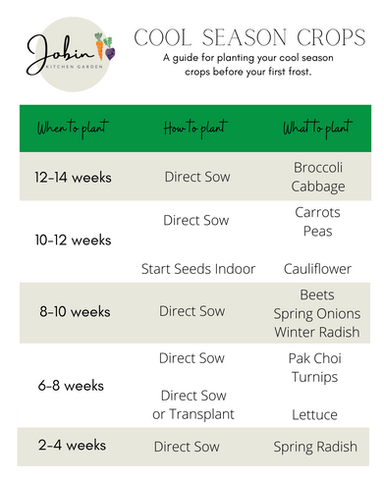Garden Duties: Fall Garden Planning
- Sophie Jobin

- Aug 2, 2020
- 2 min read
Updated: Sep 11, 2022
It's the middle of summer and guess what? It's time to start thinking about a fall planting. That's right, I said it, fall. As a gardener, we have to think a season ahead.
The cold frost is just around the corner. The heat will soon die down and the days will be getting shorter. Preparing early enough can help ensure that you have a successful fall harvest.

Where to Begin?
First things first, check when the first frost date is expected in your area. Knowing this can help you count backwards to find the best time to plant any vegetables.
One thing to remember is that Mother Nature is in charge here. It's no guarantee that the frost date won't come sooner or later, so take it as an average not as a set in stone date.
If you wanted to see when your average first frost date is: Canadian Hardiness Zones
Here in Halifax, Nova Scotia it's around October 11-20.
What's Next?
Check how long your new crops will take to mature.
Information on crop maturity is listed on the back of most seed packets.
If you buy a transplant, sadly it won't always have a tag to let you know this information. Knowing the type of variety will allow you to look it up on the internet.
For most up north, our fall growing season isn't long. If you don't have a season extender, like a greenhouse or a cold frame, it can limit what you end up growing. For myself, I might have around 3 months (90 days) left of ground or raised bed planting.
Something to keep in mind: plants grow slower in the shorter, cooler days of late summer and fall. It's advised to add 7-10 days on top of the days to maturity listed on the seed packet.
Also to Consider
Is your crop able to handle the cooler weather? Not all plants can survive temperature drops. Some plants love the heat, once the cold weather crosses their path it can cause a lot of damage to the plant, event kill it.
For example: Basil plants are sensitive to frost and any prolonged exposure to cooler temperatures can damage or even kill the plants. Even temperatures below 10 degrees can stunt the growth and might damage leaves.
Some Vegetables to Plant for Fall
Lastly Plan Out Your Fall Garden
The best thing you can do for yourself is map it all out before you start to seed anything in the ground.
There's a couple of ways to do this:
If you have a book or journal, plot out your gardening area and:
Write down the name of each plant.
Indicate where it was planted.
Add the date you planted it + days to maturity.
Season and Year it was planted.
If you don't like the idea of writing it down, there are some apps to help plot out your garden beds.
One I like using is Veggie Garden Planner:
It helps you plan out your garden bed season after season.
It helps you know if two plants are compatible.
It also helps you understand crop rotation.
It's free.
The beauty of fall planting is there's less competition from weeds and plenty of seeds to choose from. So it's not too late to get planting.
What are you growing this fall? Tag #jobinkitchengarden on Instagram and Facebook or leave a comment below!
Pin to Pinterest












Comments